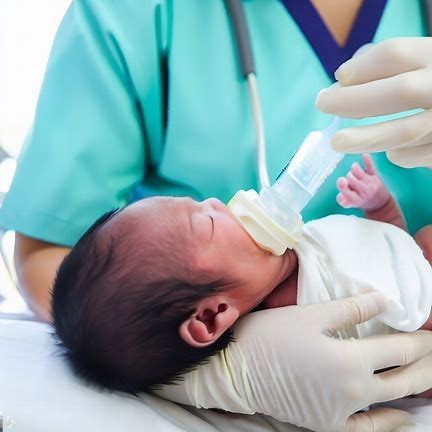The nurse is preparing the nursing care plan for a newborn who was born via cesarean delivery. Which diagnosis should the nurse prioritize?
Ineffective thermoregulation related to heat loss to the environment.
Altered nutrition less than body requirement related to limited formula intake.
Altered urinary elimination related to post-circumcision status.
Ineffective airway clearance related to mucus and water secretions.
The Correct Answer is D
Ineffective airway clearance related to mucus and water secretions. This is because newborns who are born via cesarean delivery are at risk for respiratory distress due to the lack of compression of the chest during birth. This can result in retained mucus and fluid in the lungs that can interfere with breathing and oxygenation. The nurse should prioritize clearing the airway and monitoring the respiratory status of the newborn.

Choice A is wrong because ineffective thermoregulation related to heat loss to the environment is not specific to cesarean delivery. All newborns are prone to heat loss due to their large surface area and thin skin. The nurse should maintain a warm and dry environment for the newborn and prevent exposure to cold surfaces.
Choice B is wrong because altered nutrition less than the body requirement related to limited formula intake is not specific to cesarean delivery. All newborns need adequate nutrition to support their growth and development. The nurse should monitor the intake and output of the newborn and assist with feeding as needed.
Choice C is wrong because altered urinary elimination related to post- circumcision status is not specific to cesarean delivery. Circumcision is an elective procedure that may or may not be performed on male newborns. The nurse should provide wound care and pain relief for the circumcised newborn and observe for signs of infection or bleeding.
Nursing Test Bank
Naxlex Comprehensive Predictor Exams
Related Questions
Correct Answer is A
Explanation
Massage the fundus. This is because massaging the fundus (the upper part of the uterus) can help the uterus contract and prevent excessive bleeding after delivery. A soft, boggy uterus indicates uterine atony, which is a failure of the uterus to contract sufficiently after childbirth.
Uterine atony is the most common cause of postpartum hemorrhage, which can be life-threatening if not treated promptly¹².
Choice B is not correct because initiating measures that encourage voiding is not the appropriate intervention for a soft, boggy uterus. A full bladder can interfere with uterine contractions and cause bleeding, so it is important to empty the bladder after delivery. However, this should be done after massaging the fundus.
Choice C is not correct because positioning the patient flat is not the appropriate intervention for a soft, boggy uterus. Positioning the patient flat can increase blood loss and reduce venous return. The patient should be positioned with the head slightly elevated and the legs flexed to improve blood circulation and prevent shock³.
Choice D is not correct because notifying the doctor is not the first intervention for a soft, boggy uterus. Notifying the doctor is important if bleeding persists or worsens despite massaging the fundus. The doctor may order medications or other treatments to stop the bleeding and prevent complications¹.
Correct Answer is C
Explanation
ask the client to empty her bladder. A full bladder can cause the uterus to be displaced and lead to excessive bleeding. The moderate lochia rubra, normal temperature, soft breasts, firm fundus, slightly deviated to the right, pulse rate of 88/min, and respiratory rate of 18/min are all normal findings.
Choice A is not correct because the client's milk will come in regardless of nursing frequency.
Choice B is not correct because the client's temperature is within normal limits.
Choice D is not correct because there is no indication of an increase in IV fluids.
Whether you are a student looking to ace your exams or a practicing nurse seeking to enhance your expertise , our nursing education contents will empower you with the confidence and competence to make a difference in the lives of patients and become a respected leader in the healthcare field.
Visit Naxlex, invest in your future and unlock endless possibilities with our unparalleled nursing education contents today
Report Wrong Answer on the Current Question
Do you disagree with the answer? If yes, what is your expected answer? Explain.
Kindly be descriptive with the issue you are facing.
